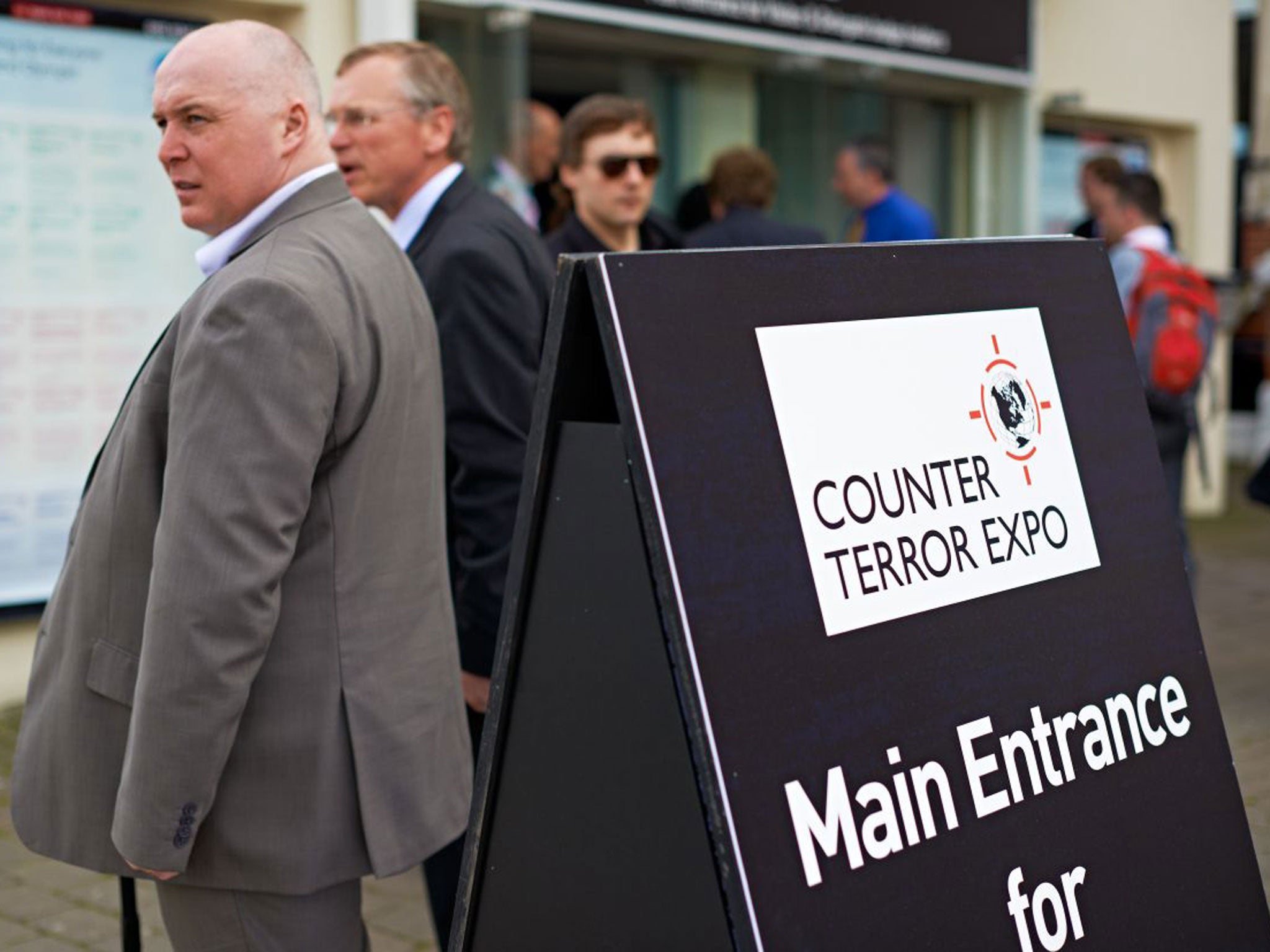Protect and survive: Welcome to London’s counter-terrorism shop window
In the wake of the Boston bombing, a display of security equipment took on a new significance

It was all going so well. The suicide attacker had been subdued and the bomb disposal robot was delicately unpicking his clothing to neutralise his device. Then a slip of the remote-controlled claws sent the cylinder of explosive rolling across the floor, scattering a gaggle of startled civilians.
Such were the perils of attending Counter-Terror Expo 2013, Britain’s premier event for showcasing and selling paraphernalia from giant armoured vehicles to sparrow-sized surveillance drones designed to deal with the threat posed by those bent on destroying lives and livelihoods.
Fortunately, in this case the home-made bomb escaping from the coat of a mannequin “terrorist” on the floor of the Northrup Grumman unmanned vehicles stand at London’s Kensington Olympia turned out to be a gaffer-taped tube of nothing more explosive than polystyrene.
There could be no doubting the serious intent of the event, which is a shop window for a multibillion market for British and other manufacturers who make their money selling the equipment, from unfathomable quantities of vehicle bollards to airport scanners, that have become a necessity in the post-9/11 world. According to one estimate, global spending on counter-terrorism is about $70bn (£45bn) a year.
But the sales patter about ballistic vests and facial recognition software was also tinged with recognition that the bombing at the Boston marathon had proved that there are deadly threats which no existing technology can prevent.
Jessica Conway, sales manager for American X-ray and explosive detection company Auto Clear, said: “Of course technology can help but when you are in an open-air situation like we saw in Boston with people moving freely, it is extremely difficult to detect an attack. The best asset would be sniffer dogs, which are more sensitive than any machine. But even they get tired.”
The acknowledgement of counter-terrorism’s grim article of faith that an attacker only needs to be lucky once to succeed nonetheless did little to dent the enthusiasm – or the testosterone-fuelled buzz in the sprawling hall?. Among the stalls attracting the most interest was the Throwbot, a rodent-sized titanium robot camera capable of being thrown 30m (98ft) and wheeling its way into enclosed space to film terrorists and relay back their conversation. Costing £10,000 each, British users include the Metropolitan Police, which bought four of them for last year’s Olympics.
Barry Harris, head of international sales for the Throwbot’s American maker, ReconRobotics, said: “American law enforcement have adopted the technology widely and openly. But the further east you go, the more difficult it becomes. We have good sales in Europe, but clients prefer not to talk about it. China should be a big market but they less need. Many places still prefer to kick down doors and take out a target that way.”
Amid the thicket of surveillance drone manufacturers was a Galashiels company specialising in paper targets for police firearms training. Amid the latter’s current offerings is a suicide bomber named “Omar” and “Kaz”, a trenchcoat-clad gunman whose weapon is interchangeable with an overlay of a can of Fosters.
And the list of those attending the show, which boasts that 46 per cent of its visitors intending to spend at least £100,000 on security equipment within 12 months and nearly one in five more than £1m, is equally eclectic. Among those on the guest lists were the Post Office, easyJet, Ladbrokes, the Pakistan High Commission and the embassies of China and Egypt.
But while other defence-related shows are more clearly restricted to military matters, campaigners warned that the realm of counter-terrorism could be all too easily blurred with measures and materials, such as surveillance technology, used by regimes with questionable human rights records.
Guerman Goutorov, chairman of Streit Group, one of the world’s largest armoured vehicle manufacturers whose clients include Yemen and Saudi Arabia, agreed that suppliers can face difficulties in ensuring that their products do not become tools of repression. “It is always a fine line. There are rules and regulations which we strictly observe and, for example, we won’t sell anything in Syria while the current situation continues. We don’t get involved in politics.”
A spokesman for the Campaign Against the Arms Trade said: “While Counter Terror Expo is primarily aimed at internal security, the links between police, paramilitary and military are very close in many countries as are the weapons they deploy. Increasingly we are concerned by the use of surveillance equipment to monitor and suppress civilian activities.”
Robot wars: Popular security gadgets
Cobra 4x4 armoured vehicle
Built by Canadian company Streit, the Cobra, available with optional gun turret, is the latest model produced for police counter-terror troops. It can also be fitted with a custom-made ladder for climbing into buildings.
Throwbot XT
Resembling a hi-tech stretched yo-yo, this wheeled surveillance robot can be thrown more than 30 metres by police or special forces personnel to enter a building and send back live video and audio. Despite its $16,000 (£10,300) cost, it is in great demand.
Kynamco Magnum Distraction Grenade
Used for training SWAT-style police units, the grenade comes with a variety of charges to habituate officers to their effect and can be fired through a double-glazed window. Stun grenades are used by hostage rescue teams to temporarily paralyse targets.
8000 Series Threat Assessment Targets
A range of 13 targets posed by models of suspects ranging from “Omar” the suicide bomber, “Darrell” a tattooed gunman, and “Swordsman & Hostage”. The targets, produced by McQueen Targets and used for training armed police, and come with overlays to swap their weapons for harmless items including a can of beer or a mobile phone.
Subscribe to Independent Premium to bookmark this article
Want to bookmark your favourite articles and stories to read or reference later? Start your Independent Premium subscription today.

Join our commenting forum
Join thought-provoking conversations, follow other Independent readers and see their replies